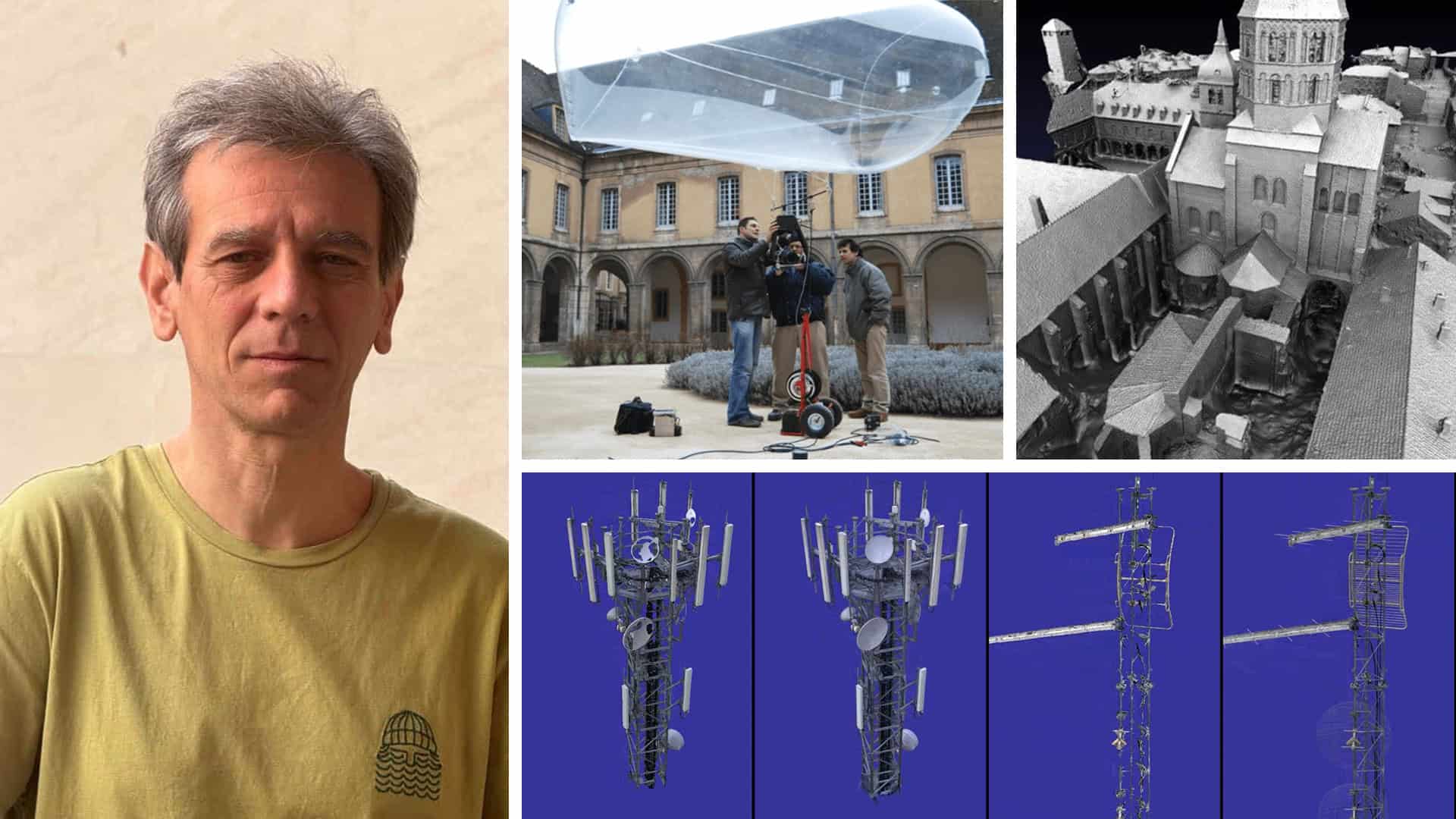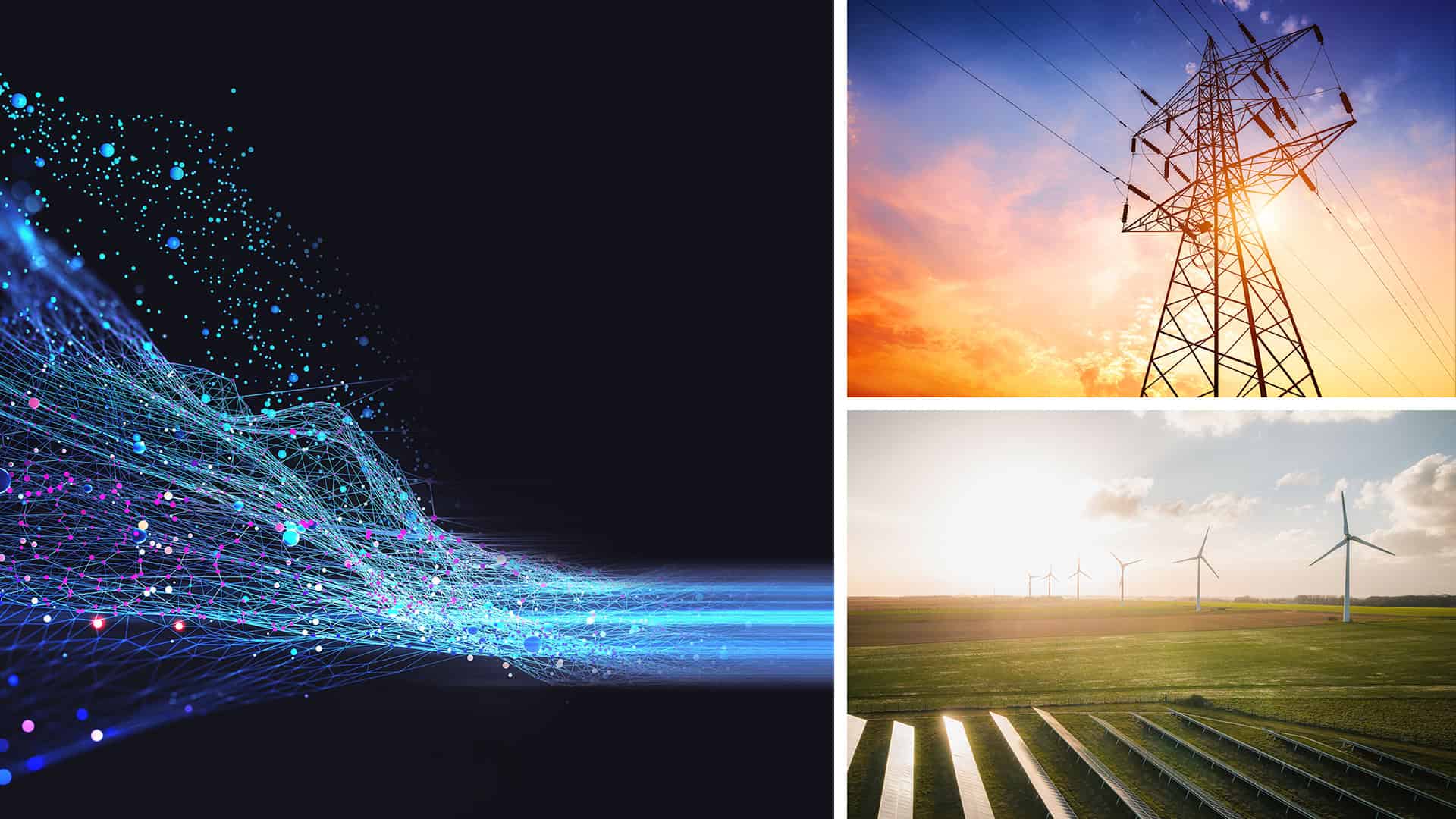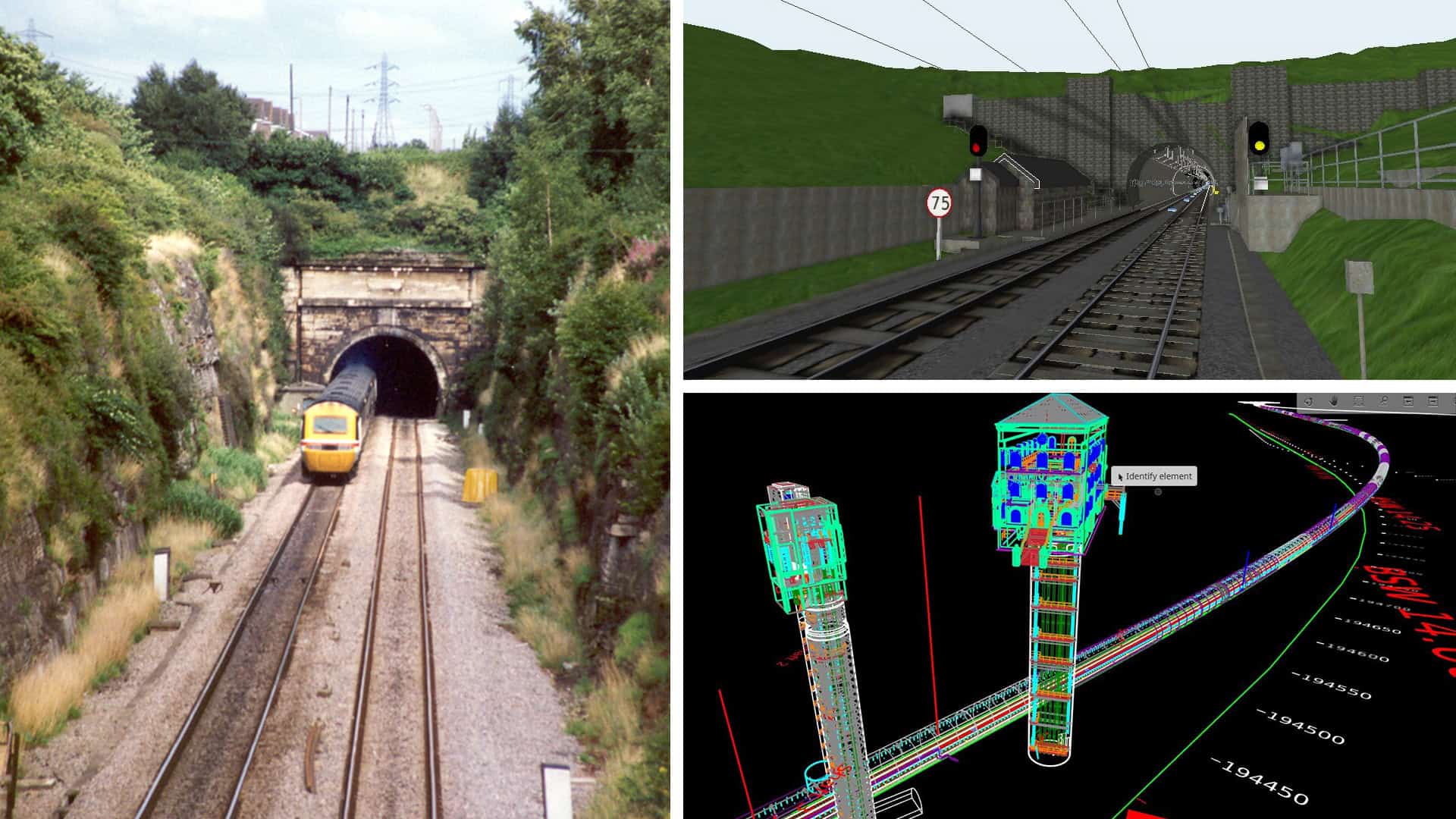The United Nations Climate Change Conference (COP28) concluded last month after 14 days of negotiations. While opinions on its success may vary, I view the outcomes of COP28 as a historic and significant stride towards achieving net zero by 2050.
Noteworthy progress was made during COP28’s pre-scheduled agenda, including the decision to involve cities at the negotiating table to ensure climate action reaches those responsible for implementing it locally, as well as agreements about how the globe can best adapt to the impacts of climate change (which I expect to cover in a future post). Most importantly, a milestone Global Stocktake agreement was reached after climate talks were forced into overtime to bridge internal divisions about how to deal with fossil fuels.
This agreement stipulates a just and orderly transition away from fossil fuels and sets a new specific carbon reduction target: tripling renewables and doubling energy efficiency by 2030 to help close the energy transition gap and get on a 1.5°C pathway. Supplemented by other governmental commitments linked to public construction projects, this agreement will have profound implications for how infrastructure is designed, built, and operated.
Why such profound implications? Because our current infrastructure relies heavily on fossil fuels. Fossil fuels are used to generate electricity, heat homes and businesses, and power transportation systems, with significant environmental and health consequences.
An Extraordinary Opportunity for Global Infrastructure
Today, infrastructure is responsible for 79% of total greenhouse gas emissions, and new modeling suggests that air pollution from using fossil fuels in industry, power generation, and transportation is killing 5 million people worldwide annually—nearly 10 people per minute. This cannot continue and need not continue – we know what needs to be done.
Transitioning away from fossil fuels, requires the world to accelerate investment and project timelines in renewable energy, energy efficiency, and other low-carbon technologies. This requires a massive overhaul of existing and new infrastructure in the design, build, and operations phases in terms of materials used, construction methods, energy sources, and more. Frankly, almost every facet of infrastructure will need to be reexamined.
Engineers, designers, builders, operators, and other infrastructure stakeholders have an extraordinary opportunity to make tangible progress in carbon reduction goals TODAY by fully embracing existing digital tools and technologies, including digital twins and AI. These tools can help infrastructure professionals access the most mature and cheapest emission reduction levers such as circularity, efficiency, and existing renewable power technologies. Simultaneously, fully embracing digital tools plays a critical role in helping infrastructure professionals define the long-term strategies and disruptive approaches that will shape our TOMORROW by enabling them to de-risk and hyperscale the delivery of large and/or complex green capital projects such as fusion energy and low-carbon hydrogen.
After returning from COP28, I can tell you firsthand that the connection between infrastructure and climate change is far from niche. It’s been thrust into the spotlight as a key lever to help mitigate climate change. In my role, I have the unique privilege of studying how technology is applied to accelerate progress towards a net-zero future. What I’m seeing is not only inspiring but represents an ever-expanding set of roadmaps for how the global infrastructure can tackle climate change.
Accelerating Decarbonization with Digital Twins, AI, & Simulation
Transitioning to renewable energy grids, reducing embodied carbon in projects, and driving energy efficiencies in operating infrastructure are among the myriad of ways that the infrastructure sector is playing a leading role in mitigating climate change. As I reflect on COP28, four projects stand out in my mind as embodying the level of technology adoption that the entire sector will need to embrace to accelerate decarbonization.
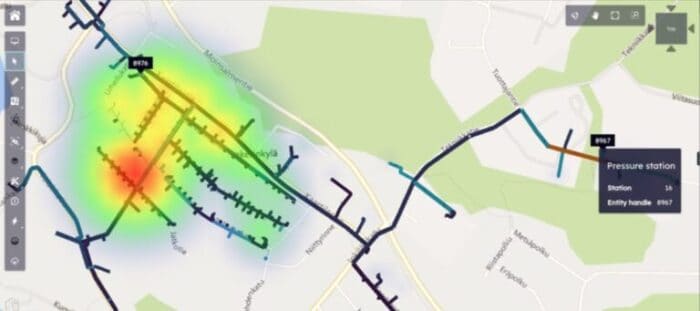 A screen capture that shows a data-driven approach to determining how to prioritize maintenance activities for Helsinki’s city-wide heating system. Courtesy of Silo AI.
A screen capture that shows a data-driven approach to determining how to prioritize maintenance activities for Helsinki’s city-wide heating system. Courtesy of Silo AI.1. Silo AI: Smart Asset Management for Improved Efficiency
The quickest way to decarbonize and transition away from fossil fuels is by optimizing and increasing the efficiency of existing assets and infrastructure. For example, intelligent digital twins are being used in pipe networks (such as district heating or water distribution systems) to generate actionable insights related to detecting anomalies, such as pipe leakages, bursts, or pump operation inefficiencies. These data-driven approaches can greatly reduce water, energy, and carbon footprints.
In Helsinki, this approach is being applied by Silo AI to enhance the city’s heating system with a unified data-driven asset optimization service. By determining how to prioritize maintenance activities where leaks are likely to occur, the pipeline owner-operator can lower water loss and prevent blockages and outages. AI-driven cooling analysis enables a 3-degree Celsius temperature reduction, enhancing energy efficiency and reducing fuel consumption. with a unified data-driven asset optimization service. By determining how to prioritize maintenance activities where leaks are likely to occur, the pipeline owner-operator can lower water loss and prevent blockages and outages. AI-driven cooling analysis enables a 3-degree Celsius temperature reduction, enhancing energy efficiency and reducing fuel consumption.
2. KPIL: Scaling Renewable Energy in Rural Cameroon
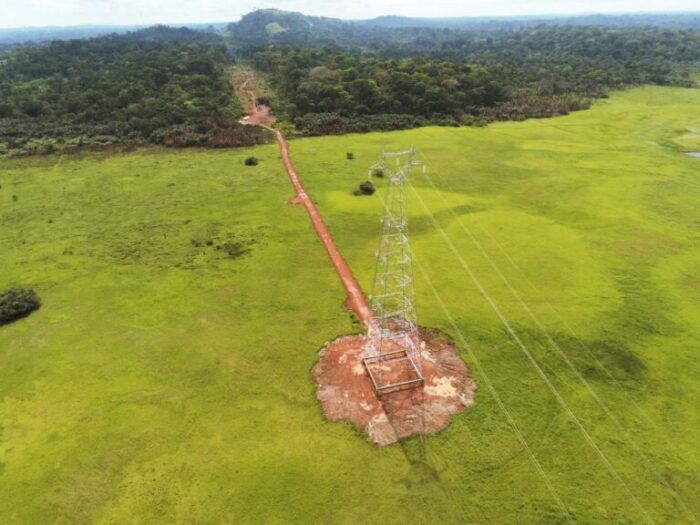 Digital twins and AI were used in a project to help improve regional access to a sustainable power supply in rural Cameroon. Courtesy of KPIL.
Digital twins and AI were used in a project to help improve regional access to a sustainable power supply in rural Cameroon. Courtesy of KPIL.Transitioning away from fossil fuels also depends on (hyper)scaling renewable energy, which requires the right infrastructure to generate, transmit, and
distribute clean and affordable energy effectively and efficiently. A project in Cameroon provides a strong example of how digital twins and AI can be used to help scale the delivery of renewable energy.
Although only 25-30% of Cameroon’s electricity mix is based on fossil fuels, more than 50 percent of Cameroon’s population still lives in poverty with limited grid connectivity and unreliable power supply. A new plan to build 225-kilovolt transmission lines and supporting substations will extend the country’s electricity network, enhancing grid connectivity and improving regional access to a sustainable power supply.
To help streamline workflows and monitor costs and materials associated with the project, Kalpataru Projects International Limited (KPIL) created a digital twin of the project for use in the engineering and design phases. They have incorporated data from AI and the Internet of Things into the digital twin to provide digital visibility and automated insight for real-time holistic project monitoring to keep the grid running. The adopted digital, data-driven strategy allowed KPIL to reduce project completion timelines by 9%, de-risking the project, which is a critical part of our decarbonization pathways: we have no more margin for failures or delays. It’s the opposite – we must find ways of anticipating and scaling up decarbonization projects.
3. ITER: De-risking a Disruptive Power Source
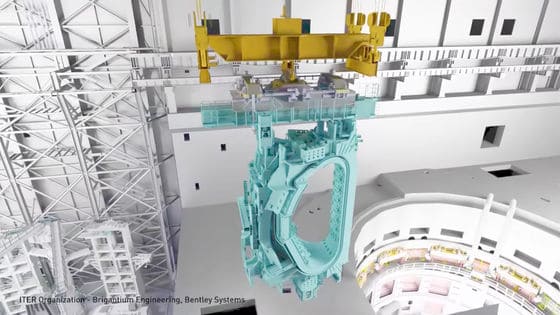 Digital rehearsals done as part of the ITER project help reduce material usage and drive transportation efficiencies. Courtesy of Brigantium Engineering.
Digital rehearsals done as part of the ITER project help reduce material usage and drive transportation efficiencies. Courtesy of Brigantium Engineering.Indeed, today’s technology is also being used to de-risk moredisruptive, long-term approaches to addressing net-zero goals ensuring that the infrastructure project delivery for technologies such as fusion, low-carbon hydrogen, and carbon capture (in “hard-to-abate” sectors) are delivered on time. The international nuclear fusion research and engineering megaproject known as ITER aims to create energy through a fusion process akin to that of the Sun. I had the pleasure of meeting with Nitendra Singh (ITER Project Associate) in Dubai, who shared with me his excitement about the implications of leveraging our software in the project. Through immersive (virtual) reality, the team simulates operations in future plant facilities, allowing them to anticipate, detect, and review design issues, ensuring smoother and more effective project delivery, critical in such a complex project.
Moreover, using 4D construction planning, the project team digitally rehearses and tests the assembly of thousands of components, allowing for designs to be perfected before they are manufactured. This approach’s impact on materials efficiency and transport costs cannot be understated, particularly when it involves 1,500-ton assemblies.
ITER’s utilization of digital technology underscores another critical aspect of the infrastructure sector’s carbon footprint: material usage. Historically, much of the sector’s carbon reduction efforts have focused on reducing infrastructure projects’ “operational” carbon emissions. However, the production and use of materials such as cement, steel, and aluminum have a significant and well-understood carbon footprint, adding to the fact that infrastructure is responsible for 60% of all materials used. While the sector’s focus on mitigating “embodied” carbon has lagged, it’s catching up. Here again, technology is playing a central role.
RELATED: The Joy in the Promise of Nuclear Fusion
4. WSP: Decarbonizing by Optimized Design
Carbon can and should be fully quantified and optimized from the earliest design stages. Take for example WSP’s work to help meet carbon reduction goals in their design of UK headquarters for global banking giant, Santander. By working to eliminate the amount of concrete wherever possible with structural analysis software, WSP achieved a remarkable reduction of 3,000 tons in carbon emissions. Additionally, incorporating the crane foundations into the slab saved another 50 kilograms of emissions with the help of geotechnical software.
 WSP lowered the amount of concrete needed by 16,000 tons in their work on the UK headquarters for Santander Bank. Courtesy of WSP.
WSP lowered the amount of concrete needed by 16,000 tons in their work on the UK headquarters for Santander Bank. Courtesy of WSP.These successful projects by Silo AI, KPIL, ITER, and WSP exemplify how today’s technology is being used to accelerate toward aggressive and critical decarbonization goals.
What’s Next?
It is not an exaggeration to say that our approach to designing, building, and operating infrastructure will play a vital role in defining our success in mitigating climate change and transitioning away from fossil fuels.
The mainstreaming of infrastructure digital twins and AI has already proven invaluable to helping accelerate sustainable outcomes. As we look towards the future, I am particularly optimistic about how digital twin technology paired with the rapid advancement of generative AI will bring exponential benefits. Within the realm of the global infrastructure sector, these benefits include improving carbon assessments and automating tasks to free up time for infrastructure professionals to tackle the foundational challenges tied to mitigating climate change.
Designers, builders, and owners of infrastructure will not only need to embrace existing digital technology and intelligent digital twins more thoroughly, but also find ways to increase cooperation and ecosystem partnerships to remove silos and drive new breakthrough innovations (partnering with reference international organizations such as the United Nations Global Compact, Global Covenant of Mayors, or International Coalition for Sustainable Infrastructure are recent examples of Bentley’s quest for more collaboration).
This combined approach is key to future-proofing existing infrastructure assets and delivering climate change solutions today while, in parallel, allowing us to hyperscale the most complex green capital projects with the climate solutions for tomorrow.
What I’ve shared above is only a tiny sliver of an ever-growing number of examples of how technology helps us address climate change. It’s up to each one of us to take the initiative to learn from each other, widen our circle of stakeholders, and take full advantage of the technology available to us today to meet the monumental challenges at hand.
View Bentley Sustainability Stories for more examples of how technology is helping to decarbonize and build climate-resilient infrastructure.



